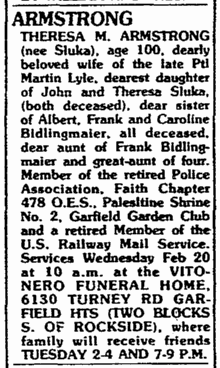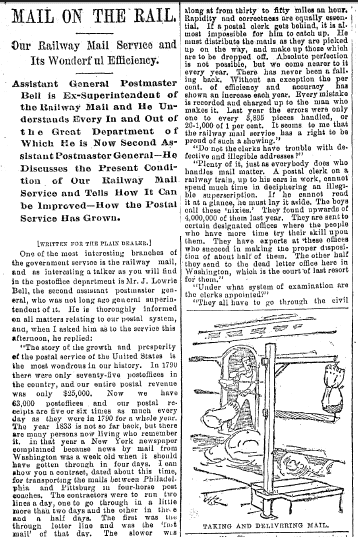Introduction: Scott Phillips is a genealogical historian and owner of Onward To Our Past® genealogy services. In this guest blog post, Scott discovers his centenarian cousin once worked for the U.S. Railway Mail Service—and delves into some railroad history.
As a genealogical historian, one of the aspects of family history I love the most is discovering something new about an ancestor. Then I can take some time off from working on my family tree and spend it learning about this new aspect, or area, that I have uncovered. So it was recently as I found myself once again working on my Bohemian (Czech) ancestors in Ohio.
This time I was delving into one of my first cousins, twice removed, Theresa (Sluka) Armstrong. I was reading her obituary in GenealogyBank.com and among all the other tidbits of great information I was finding, I came upon the statement that she was a retiree of the United States Railway Mail Service.
As you can see by reading my cousin’s obituary, Theresa was 100 years old when she passed away. She must have loved the city as she was the wife of a Cleveland policeman and the sister of Frank and Albert Sluka, who were also both Cleveland policemen. (You can read about the tragic murder of Albert Sluka in my previous GenealogyBank.com blog article found at https://blog.genealogybank.com/author/scottphillips.)

The more I thought about it, the more intriguing this organization called the United States Railway Mail Service became to me. Additionally, I found it quite interesting that my female cousin worked for them. Having never heard of it before, I began investigating her occupational history with the railroad almost before I realized it.
Still on GenealogyBank.com, I began searching on “U.S. Railway Mail Service” and was instantly treated to amazing railroad background and historical information.
Unbeknownst to me, in about 1863, the United States Postal Service began outfitting and utilizing specially-designed railway cars to accommodate the collecting, sorting, and distributing of mail aboard railroad trains as they traversed across the United States as an integral part of the early postal system. This efficient railway system was even designed so that at many locations, usually smaller, rural towns where the train did not stop, mail pouches were hung by the railroad tracks where a special “arm” attached to the train would snag the bag while moving. Then the postal clerks on board would retrieve the pouches, open their locks, and sort and process the mail as the train roared along. The train never slowed down or missed a beat!
Quickly I was treating myself to multiple stories about the development, history, and operations of the United States Railway Mail Service. One of my early favorite stories was from an 1891 newspaper article that not only explained the functioning and design of this delivery service, but even contained a drawing of what the mail pouch pick-up looked like.

Then I really found myself hitting pay dirt with a 1909 newspaper article from North Dakota. This historical article is an entire page of the newspaper explaining in detail the U.S. Railway Mail Service and containing six extraordinary photographs of the working areas of these specialized train cars. It even contains the names of the postal clerks working that run. Lists of employee names are always a treat for genealogists and family historians!
I am now engaging in a full pursuit of finding the employment and pension records for my cousin, which for the U.S. Railway Mail Service are held at the Civilian Personnel Records Department of the National Personnel Records Center, housed at the National Archives and Records Center in St. Louis, Missouri.
I am keen on discovering more about the employment history of my centenarian cousin and finding out if her working career involved actually “riding the rails” or staying on the solid ground at the station in Cleveland.